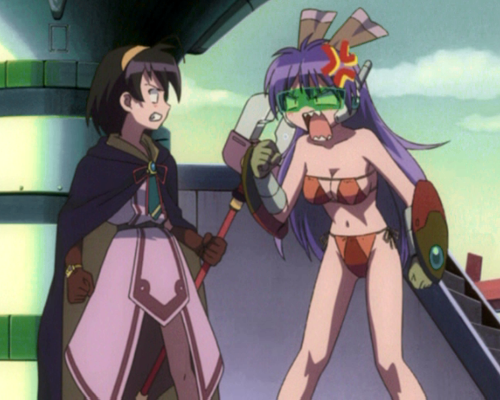Tristia of the Deep Blue Sea is doomed to obscurity. It was based on a PC game that never left Japan, it lasts only two episodes, and it was quietly released in 2004 by the foreign-film label Pathfinder Pictures, which hasn't touched anime since. At this point, it's safe to say that Tristia's not going to get shown on Adult Swim or inspire piles of merchandise at hipster fashion stores. If anything, it'll only draw tiny, devoted cells of fans to debate which of its characters is the cutest.
That's because Tristia is a moe series. There's extensive debate over just what “moe” means, but, in practicality, it most often refers to fans obsessing to unhealthy extremes over cute anime girls doing cute things in the cutely cutest way. The leading cute girl in this case is Nanoca Flanka, a young engineer helping to rebuild the island city of Tristia with a giant “golem” robot named Tenzan and a talking wolf named Stuka. She's befriended by a host of upbeat stereotypes: Nene's her fretful blond admirer, Faury's an older, bustier businesswoman, and Rafarew is a deadpan, green-haired robot girl . The closest thing to a villain is Nanoca's bitter college rival Panavia Tornado, who arrives one day with a huge golem of her own and a challenge for Nanoca to face her in an upcoming multiple-golem battle royale.
I could go on about how Tristia's plot is a spare regurgitation of clichés, and how the series never gets any more interesting than a battle between Nanoca's friends and Panavia's rogue golem, which is driven insane by way of some military-industrial conspiracy among the Tristia authorities. Yet that'd miss the point. Tristia isn't about plot or character development. It's about sugary-sweet comedy, it's about winking references (half the characters seem named after fighter planes), and, above all else, it's about adorable and frequently childish female characters having quaint little adventures.
No, Tristia's problem isn't its lazy script. Tristia's problem is that it doesn't even work as a fluffy diversion. Nanoca and her friends are unmemorable on the whole, and the humor that surrounds them rarely hits the mark; at best, you'll get a chuckle out of a hulking robot trying to chop cabbage. The simplistic plot relieves Tristia of the confusing nonsense common to videogame-based anime, but its roots are bluntly apparent elsewhere: there's no attempt to explain the setting, and many of the supporting characters simply don't do much of anything. The exception would be Faury, who's required by plot mechanics to get half-naked at least once every thirty minutes.

|
|
It's wacky because she has that red thing coming out of her head. No, really. It is. Ha ha. Ha.
|
Tristia, like other moe-intensive productions, at least knows its audience: fans of the computer game series who, for one reason or another, wanted to see as much of the cast as possible. And while Tristia is generally reserved in its titillation, some parts are, for want of a better term, really fucking creepy. Faury jiggles her way through the production in standard anime fashion, but it's harder to shrug off scenes of the apparently pre-pubescent Nanoca and Nene bathing together. The series even mocks this with a radio-show epilogue in which the characters answer reader-submitted questions like “Are Nanoca and the girls wearing any underwear?” For reasons clearly never intended, this is the funniest part of Tristia.
To throw Tristia some praise, the animation's impressive for a low-profile OVA release, with sharp robot battles and overall competent direction from Hitoyuki Matsui, who'd go on to tackle the much funnier Ninja Nonsense. Pathfinder's DVD is bare-bones, however, with limited extras, no dub track, and even a lack of chapter stops. At least the Japanese voice acting's generally inoffensive, and this is coming from someone who's usually driven up the wall by squeaky feminine tones in anime.
In fact, Tristia has no impact at all, save for a vague sense of wasted time and repellent subtext. It may be prettier and slightly more tolerable than other saccharine moe anime extracted from semi-obscure computer games, but its thoroughly bland aura and pandering moments kill any reason to watch it. In every way, Tristia deserves to be forgotten.